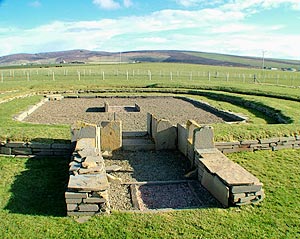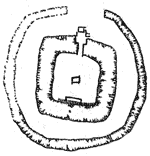
 |  |
| Home |
| About Orkney |
| History |
| Tradition |
| Folklore |
| Placenames |
| Images |
| Downloads |
| About the Site |
| Contact |
| Links |
| Search Site |
| Awards |
| The Barnhouse Neolithic Settlement | |
| Structure Eight - a Neolithic temple? Lying directly opposite House Two are the remains of one of the largest, covered structure from Neolithic Orkney discovered to date. This building, built around 2600BC, after the village had been abandoned, was a massive, hall-like structure, seven metres square, with incredibly thick outer walls. The structure was built on a platform of yellow clay - a feature paralleling the nearby cairn of Maeshowe (see right column). Structure Eight's clay platform was enclosed by a circular wall, creating an internal courtyard over 20 metres across.  Ritual complex Because the complex's spatial layout closely resembles that of the nearby Standing Stones o' Stenness, it is highly likely that the building was involved in ritual of some sort. However, we can only guess at the form these rituals took.
To access the central enclosure, the Stone Age visitor had to first pass through a three-metre long entrance passage. Built into the floor of this passage was a hearth, flanked by two standing stones. Although this hearth was probably paved over, its presence is interesting and probably symbolic - perhaps representing some form of ritual purification that took place before the individual was permitted to enter the inner chamber. On the other hand, it may be that the hearth was simply the remnant of a foundation ceremony that took place before the construction of Structure Eight began. Either way, its presence once again highlights the importance placed on the hearth in Neolithic Orcadian culture. The significance of the dresser Inside, things were more or less the same as the smaller houses, with a large central hearth and stone dresser, similar to those found in practically all late Neolithic houses. What the discovery of the dresser in Structure Eight proved to archaeologists was that it was more than a mere item of furniture and probably had ritual or religious significance. During the excavation, a complete Grooved Ware pot was found to have been set into the clay floor by the eastern wall of the central building. This pot, undecorated except for the rim area above ground, contained 14 flint nodules - a quantity that would have been regarded a treasure hoard at the time, given the scarcity of flint in Orkney. Changing religious practices?
But what was it for? The construction of Structure Eight seems to indicate a change in religious and ritual practices of the time. Where once the ceremonies took place within the stone circles, open to the entire community, by the time Structure Eight was built things seem to have changed. The rituals and religious ceremonies now took place in an enclosed space that was accessible to a select few. It has also been pointed out that the design of Structure Eight closely follows the layout of the Standing Stones o' Stenness. So were the builders of Structure Eight trying to recreate the sacred space of their predecessors but in way that would suit the changing beliefs of the time? |
The walls of the central building in Structure Eight were three metres thick. Meanwhile, the entrance on the outer wall faced Maeshowe. Like House Two, Structure Eight also shares some layout similarities with the nearby cairn of Maeshowe. Maeshowe was also constructed on a platform of clay but was surrounded by a ditch and bank instead of an enclosing wall. Symbolically, however, the two structures are complete opposites. Whereas Maeshowe is aligned to the winter solstice, the darkest period of the year, Structure Eight seems to have been aligned to the summer solstice, a time of light. So if Maeshowe represented death, did Structure Eight represent life? Although Structure Eight was probably used for meetings and feasting, excavations revealed that the central fire was not used for the preparation of food. All cooking was carried out in the courtyard between the inner and outer walls. The layout of Structure Eight's entrance is closely paralleled by the layout of the hearth found within the Standing Stones o' Stenness. There, a hearth was also flanked by a pair of standing stones. |

